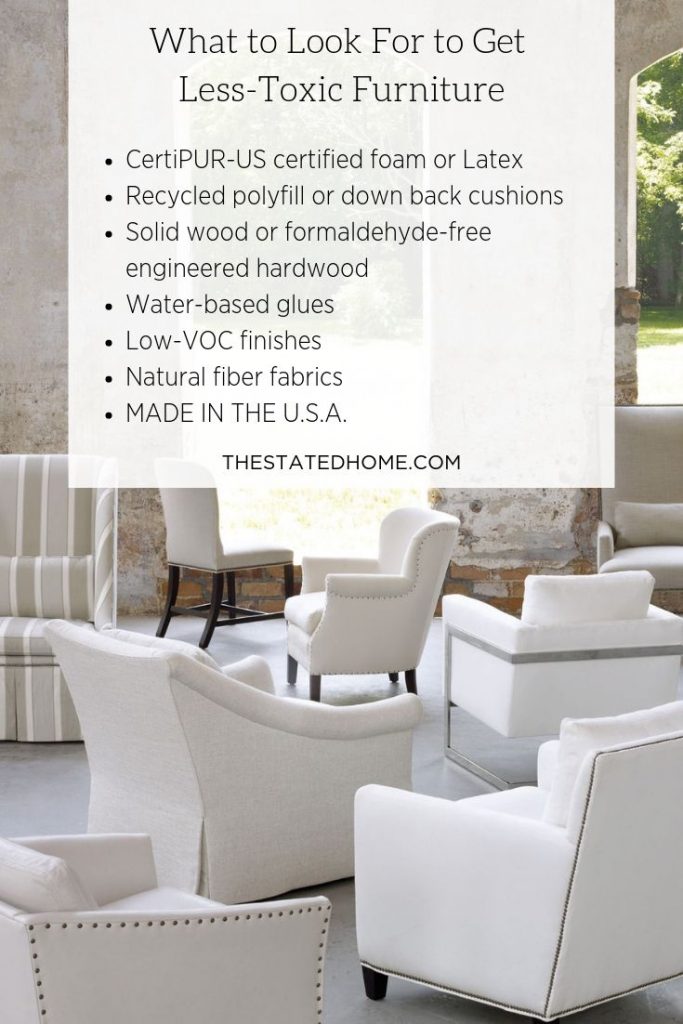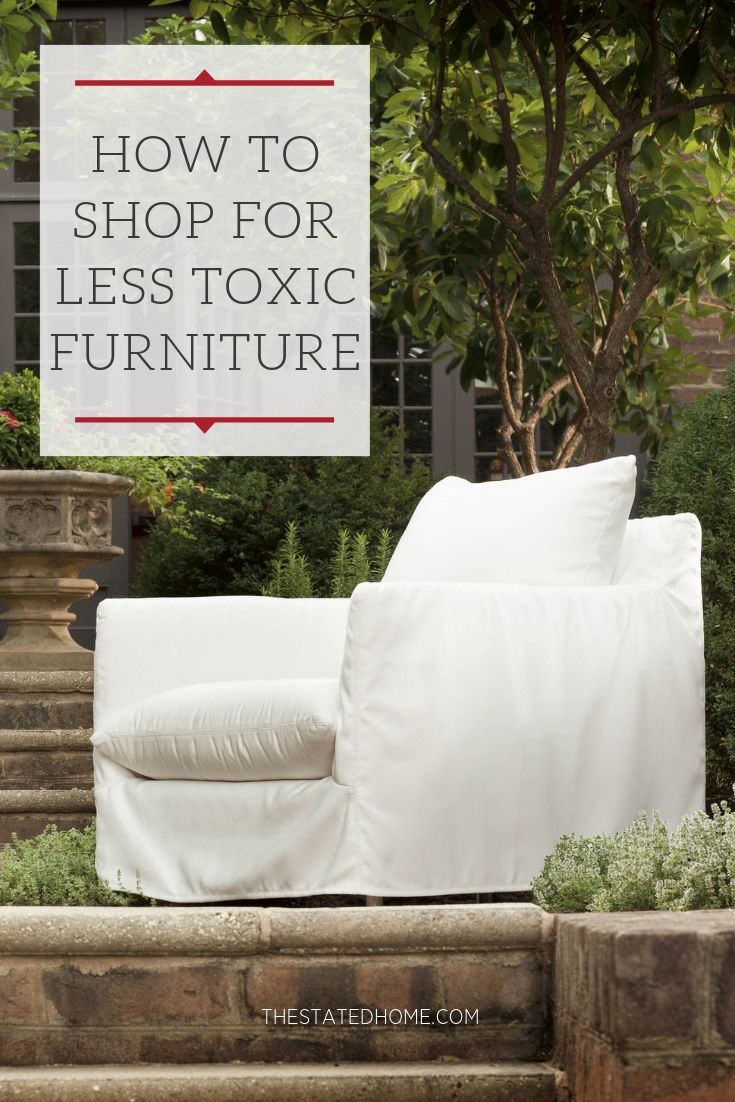
It seems like everywhere you turn, there’s something lurking in a product ready to kill you: nitrates in your bacon, parabens in your face lotion, even food dye in your delicious cupcake! And sadly, furniture isn’t innocent. The problem is that plenty of manufacturers use toxic materials, from glue to foam to finishes. In fact, many of the products used in furniture construction can contain cancer-causing chemicals. You can’t avoid them completely, but you can greatly minimize your exposure by shopping for less-toxic products. You just need to know what to watch out for.
The main culprits here are formaldehyde and VOC’s (Volatile Organic Compounds). You may have come across that term if you’ve ever shopped for paint, since there are a lot of “Low VOC” or “No VOC” options there. VOC’s are chemicals that are emitted from things like paint, glue, and cleaning products and they can be not-so-good for your health. The good news is that there are low-VOC options for most kinds of materials. The bad news: Not every manufacturer uses them.
We’re going to dive in here about all the potential places toxins can appear, then explain what responsible manufacturers are doing to reduce the emission of them into your home.
Upholstered Furniture
The Issue: Cushion Foam and Fills
You can’t get a seat cushion without foam, and most foam is made from petroleum. Called polyurethane foam, it’s full of chemicals that may off-gas in your home. Making matters worse is that polyurethane foam has been traditionally treated with flame-retardants, which proved to be an even bigger health issue. Recently, people have realized that flame retardants are largely unnecessary and causing more harm then good. As a result, manufacturers are moving away from using flame-retardants here in the U.S. (though imported furniture may still contain fire retardants).
So what about the foam? In a New York Times article about foam used in mattresses, Steven Safe, a professor of toxicology at Texas A&M, explained that the chemicals in foam don’t really leach out in big enough quantities to be a major health issue. And in this article, Wirecutter tested popular “bed-in-box” mattresses that use polyurethane foam. They were found by CertiPUR-US to have less than 0.5 ppm V.O.C. emissions. As long as furniture manufacturers incorporate foam like this, the amount of chemicals emitted is negligible.
Still, many manufacturers are trying to reduce the amount of petroleum they use in their foam. There are foams now that replace up to 30% of petroleum with a soy-based product (this is the foam used in the Lee Industries products we sell on The Stated Home). We love this since it reduces chemicals!
The only natural foam option is latex, but even that has some issues. First, some latex foam is blended with a petroleum product. Latex foam is also a lot more expensive then polyurethane foam, so depending upon your budget, it may not be an option. And lastly, there are very few sofa manufacturers that offer latex foam, so you’re limited in style options.
But foam isn’t the only plush material in your sofa – upholstery also has fiber wrapped around the cushion cores and frame and filling the back cushions. That’s another source of chemicals, since most upholstery manufacturers use a polyester fiberfill (the same stuff that’s in bed pillows and stuffed animals).
We’re going to be blunt here: Polyfill is not great for the earth or your health. It’s made from petroleum, requires a lot of energy to make, and contains some gross chemicals. So what’s a sofa shopper to do? The natural option here is wool or cotton batting, but again, this is a more expensive option and very few companies offer this option. There are some companies trying to make polyfill a little less terrible, like our manufacturer, Lee Industries. They use a 100% recycled polyfill made from drink bottles. This fill uses less energy to produce and diverts a lot of bottles away from landfills.
Instead of driving yourself crazy trying to avoid foam and fiber, try to not worry about it too much and use these tips when shopping for upholstery to minimize toxins:
- Look for CertiPUR-US certified foam, which is made without: flame retardants, heavy metals, formaldehyde, phthalates, or ozone depleters, and are low-VOC (less than 0.5 ppm). Our upholstery from Lee Industries uses CertiPur certified foam.
- Opt for seat cushions with an innerspring core instead of a foam core – there will still be foam, but less of it.
- Shop with companies that use recycled poly-fill.
- Consider natural down back cushions (beware that these are very soft and require daily rotating and fluffing).
The Issue: Frames
Sofa frames can be made from inexpensive particle board, solid wood, and a bunch of other materials (for more on sofa frame construction visit our blog on it here). We don’t recommend purchasing any furniture (upholstered or wood) made of MDF or particle board. Not only do they not last, but they are full of nasty chemicals that off-gas into your home. You can read more about it here on our blog discussing the types of wood material.
The upholstered furniture we sell at The Stated Home has frames made from either solid wood or “engineered hardwood,” which is essentially an exceptionally strong plywood. Engineered hardwood is made by adhering thin layers of wood together. It used to be that the glues used in that process could contain formaldehyde (a proven cancer-causing chemical), but then the fearless soybean came to the rescue! There are now plywood products that use a soy-based resin to adhere the layers of wood together, making the product low formaldehyde or formladehyde-free. We’re happy to say that our engineered hardware frames use this soy-based adhesive.
Another place that toxins can lurk is in the glue used to assemble the frame. While some heavy duty resins can contain formaldehyde, most water-based wood glues are non-toxic. But how do you know what glue a certain manufacturer uses? You don’t unless you want to call up furniture manufacturers asking about their glue. What we suggest is that you find manufacturers that care about the environment and the materials they use and assume that they probably are using good glue. The line we carry, Lee Industries, uses a soy-based resin.
And just in case you need another reminder to not purchase imported furniture: The majority of overseas factories are trying to get product out at the lowest possible price and are probably using the less-expensive, harmful adhesives.
Tips for non-toxic sofa frames:
- Avoid furniture with frames made from MDF, particle board, and standard plywood
- Look for solid wood frames
- If engineered wood is used, make sure it is made with a soy-based resin
- Don’t buy imported furniture
The Issue: Fabrics
The part of the sofa that you come in contact with the most is the fabric, so it’s a good thing to focus on. You’d think a good place to start would be natural fibers like cotton and linen. But not so fast! Cotton is treated heavily with pesticides when grown conventionally. Organic cotton would be a slam-dunk winner, but there aren’t very many upholstery companies that offer that as an option. Linen is better because it’s grown with fewer pesticides, but it is typically more expensive. Also know that once you decide to go with a natural material, it will have most likely been bleached or dyed by, you guessed it, a chemical.
Man-made fabrics like polyester and acrylic are made from petroleum and, like the polyfill mentioned above, can be full of chemicals. But with polyester comes performance – these fabrics tend to be more stain- and wrinkle-resistant.
We go into much greater detail on the environmental impacts of different types of fabric in our blog post here. Until organic cotton becomes more widely available, you’ll have to weigh the options for how you live and decide what’s best for you.
The Issue: Finishes
Most pieces of upholstery has some visible wood, which is why it’s worth mentioning that wood finishes tend to be a source of VOC emissions. Luckily, there are a lot of low-VOC finish options available and manufacturers readily advertise if they use low-VOC finishes. If you don’t feel like researching, know that all of the manufacturers at The Stated Home use low-VOC finishes, so you can shop worry-free.
Wood Furniture
Looking for low-toxic wood furniture is a little simpler because you’re mainly worrying about the wood material and the finish. We talk about those a bit higher up, so we are just going to summarize it here.
The Issue: Wood Material
- Select solid wood when possible.
- Avoid MDF and particle board, which contain cancer-causing formaldehyde (you can read more about that here).
- If there’s plywood, make sure it is made with formaldehyde-free resins.
- Go with manufacturers that focus on environmental responsibility so you can assume they’ll use non-toxic glue.
The Issue: Finishes
- Look for manufacturers that use low-VOC finishes (like all the manufacturers at The Stated Home).
- Some natural finishes are available (linseed oil is a popular one), but these are not available at large furniture manufacturers. They are also less durable then lacquer-based finishes.
- Avoid imported furniture, which has a higher chance of being made with toxic finishes.
The Issue: Hardware
This wasn’t even on our radar until we had a customer ask about it. So we did some digging. Hardware can be made from several different metals, like aluminum, steel, iron, zinc, pewter, and copper. Hardware can be a single metal or a combination like brass (copper and zinc) or bronze (copper and tin).
The main thing to know about hardware is that lead might be added to brass to make it easier to cut. It’s not a lot, but you can find “no-lead” brass which uses bismuth instead.
Like glue, this is a tricky furniture material to get details on, so try not to be too concerned about the small amount of lead that may be present in your hardware. If you’re really worried about a little kid putting their mouth on your hardware, choose drawer pulls or handles made from wood, glass, or porcelain. Hardware is super easy to switch out, so don’t be afraid to purchase a new piece of furniture with metal hardware and put on new pulls or handles!
Final Thoughts
This may not ease your mind, but there is no perfect solution for totally toxic-free furniture. Just make the best choices you can to minimize exposure to harmful chemicals and move on with your life.


What about semi analine leather sofas, are they tocic?
I can’t speak to semi-aniline leathers since each one is probably processed differently. Sorry I couldn’t be more help!
Also note that leather is not an option for vegans.
Natural materials may be more expensive now, but the more the public demands materials like natural latex and solid wood, the more companies will have to comply. Production will be streamlined and costs will go down. Flat-screen TVs cost $6000 when they first came on the market but now most households can afford one.